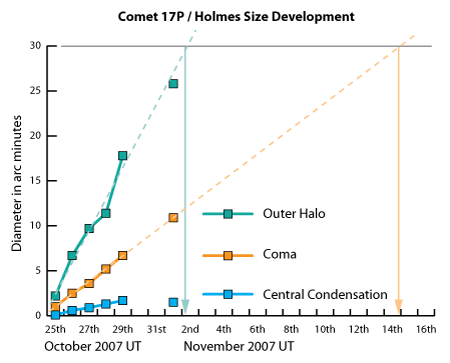With a growing collection of measurements on my list, I wanted to put together a graph showing the change in size of the comet’s main structures. As other observers have noted, the growth has been linear, so it should be straightforward to make some predictions about its size in the coming days (See this post at Cloudy Nights by Tom Polakis). I’m updating this post to include data on an ongoing basis. Here is a table of the values I’ve measured so far:
| Diameter in arc minutes | |||
| Date (UT) | Central Condensation | Coma | Outer Halo |
| Oct 25 | 0.1 | 1.0 | 2.2 |
| Oct 26 | 0.6 | 2.5 | 6.7 |
| Oct 27 | 0.9 | 3.6 | 9.7 |
| Oct 28 | 1.3 | 5.2 | 11.4 |
| Oct 29 | 1.7 | 6.7 | 17.8 |
| Nov 1 | 1.5 | 10.9 | 25.8 |
The plot of that data can be seen below:

The 30 arc minute upper limit is the approximate size of the full moon, which is sort of a popular benchmark to look for as the comet grows. I’m hoping it will be a naked eye disc under dark skies when it reaches that size–around November 14th for the bright coma by my measurements. The larger, faint outer halo could reach that size by this Thursday, but I doubt it will be remotely discernable to the naked eye. My outer halo measurement for Oct 28, 2007 (UT), appears to be out of line by the way. Obviously, this info would be better averaged with other observations. But I’m running out of time on my lunch break, so I’ll leave it at this for now.
Although the growth is linear, my instincts tell me that solar pressure should drag it into equilibrium at some point…whether that will happen before it becomes to faint to see will be interesting. Then again, maybe the particles being ejected are robust enough to resist the solar wind out beyond the orbit of Mars. I’ll check back in to see what the plot looks like after a few more days…